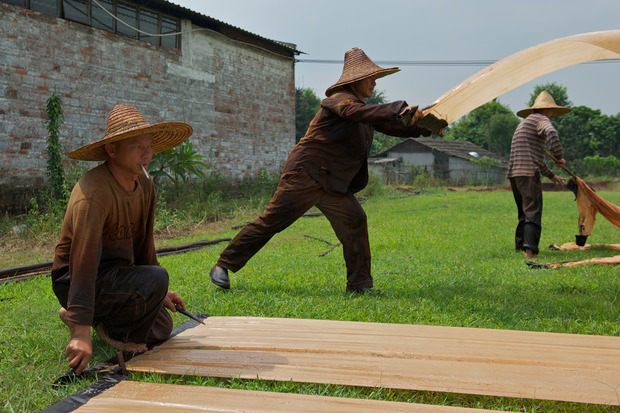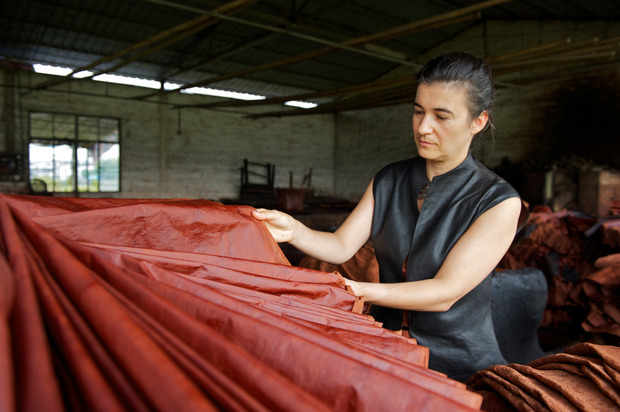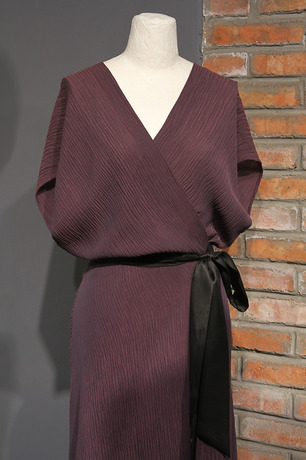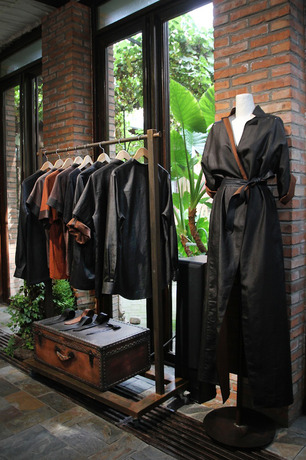Kathrin Von Rechenberg’s Tea Silk
The Beijing-based designer looks to an ancient textile technique to create sleekly contemporary attire


Tea silk considered one of the most well-preserved gems in Chinese silk craftsmanship. Originating from the Ming Dynasty, this fabric was once considered the most luxurious silk. The ’30s became the gilded age for xiangyunsha (the Chinese name for tea silk, also called langchou)—more expensive than gold, it was among the most desired goods by Southeast Asian aristocrats, and in China it became an icon of local urban elites. At that time, Shunde, the birthplace of tea silk on the Pearl River Delta, counted more than 500 factories. Unavoidably, the Cultural Revolution saw it as a symbol of capitalism and swept the industry away, but nowadays the world of luxury textiles is seeing a comeback of this ancient tradition.
One of the designers behind China’s recent tea silk renaissance is Kathrin von Rechenberg, who trained at the Ecole de la Chambre Syndicale de la Couture Parisienne and was once an apprentice at prestigious Jacques Fath Atelier in Paris. Rechenberg had her first encounter with xiangyunsha 14 years ago in Taiwan, where she was working with the designer Sophie Wong.

Rechenberg tells us that tea silk is a valuable and labor intensive fabric. “Its uniqueness lies in a complicated dying process as well as in the unique quality of the end product: tea silk is extraordinarily smooth, fresh, glossy, it’s comfortable for the skin and it’s antibacterial, thanks to a special dye bath,” she explains.
Rechenberg sends her white mulberry silk to Lunjiao, a district of Shunde: “I buy silk from all over China, cashmere from Europe but there is only one place, in Guangdong, that prepares the fabric in the traditional tea-silk way.” On the Pearl River Delta, between Jiangmen and Foshan, local craftsmen dye the fabric using exactly the same technique their ancestors used for centuries.

A particular type of yam, rich in tannin and well-known in Chinese medicine (dioscorea cirrhosa, or shulang), is finely ground and put in a clay basin until the water turns into a rusty orange color. The silk is then repeatedly soaked in the dye and laid on a grass field to dry, a process necessary to repeat up to 30 times in order to obtain deeper shades. The fabric is then taken to a river and covered by a layer of mud, to be then rinsed in the water and set to dry over night. The river has to be uncontaminated and the mud should have a buttery texture, with the right balance of iron sulfate. At the end of the process, the fabric is black on one side and rust-hued on the other. Sometimes the mud layer might be uneven and the black from the mud can show through the rusty side, which can be considered a flaw or it can add unexpectedly beautiful shades on the fabric.

In her atelier in Northeast Beijing, von Rechenberg shows us some new pieces and a couple of old ones she collected. As she explains, “The color gets darker and the texture get softer if you let the fabric age, that’s the reason why I store it for a while before using it.” Von Rechenberg’s timeless apparel has a slick look, a contemporary Chinese style which appeals to an international audience as well as to the local upper class. Simple, geometric cuts create organic shapes to wear on your body, in the soft embrace of a natural texture. Dresses, shirts, belts, shoes and clutch bags celebrate the tradition of tea silk. Every detail is carefully crafted, most pieces are hand stitched and each piece requires 30 to 40 hours of work, under von Rechenberg’s acute supervision.


Along with tea silk, von Rechenberg develops two collections a year, continuing her research on natural materials. Last season she worked around the theme of paper, and combined xiangyunsha with some pieces in washi fabric, imported from Japan. But her exploration of traditional techniques doesn’t end there: “In the future I would like to explore further dying processes, I know that in some places in southwest China, people mix indigo with yam, or use ox blood,” she says.
Von Rechenberg’s contribution to the preservation of traditional tea silk has also been featured by CCTV, the Chinese national broadcaster, in a documentary about Shunde’s production, and tea silk has been listed in China’s intangible cultural heritage.
Rechenberg’s garments are available at her showroom and at Aman Summer Palace in Beijing.
Images courtesy of Kathrin von Rechenberg












